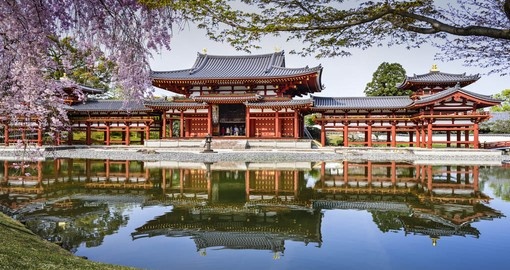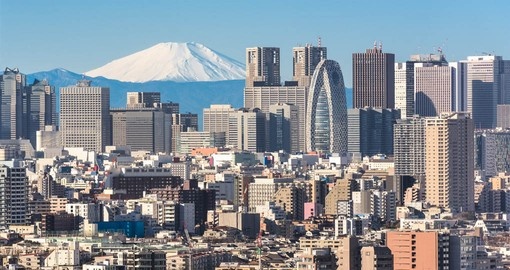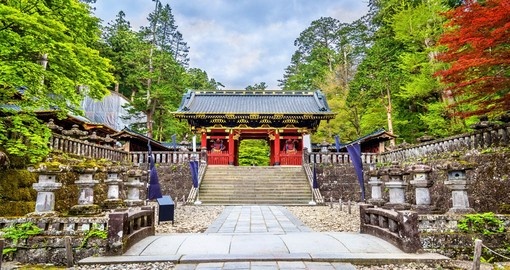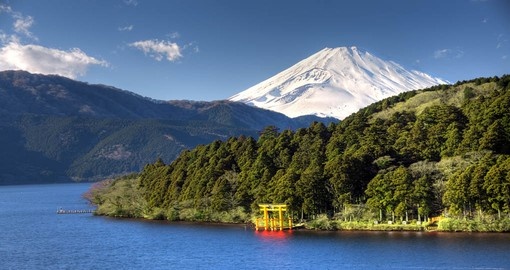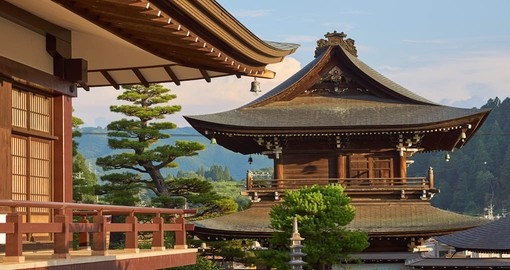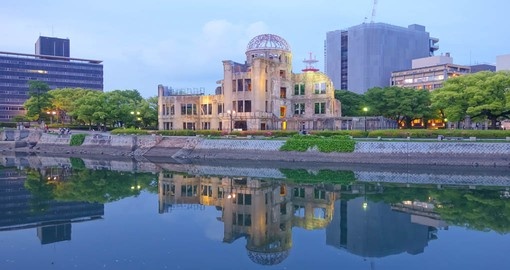Japan: Land of the Rising Sun
- Duration
- 13 Days
- Prices From:
- AU$ On Request
MODERATE | SMALL GROUP: Experience the traditional and contemporary on this journey through Japan. From the excitement of Tokyo to serenity of Nikko; from the moving Hiroshima to the beauty of Hakone.
The first thing that will strike the visitor will be the intertwining of the traditional and the modern which is the very essence of Japanese culture. Long lasting traditions pervade all aspects of life here and will fascinate the North American. Contemporary high rise buildings contrast with an abundance of serene temples and shrines. The many beautiful ornamental gardens and ancient castles will bring to life a different era.
High speed Bullet trains will transport you from city to city through interesting and scenic countryside and on arrival, you will be able to immerse yourself in a traditional culture through attending age old tea ceremonies or perhaps attending a performance of Kabuki, the ancient form of drama,
Start in Tokyo, the capital since the late 1800’s. During your time here, visit the Tokyo Tower with wonderful views of the city, the beautiful and imposing Imperial Palace Gardens and the old quarter of Asakusa with its functioning KannonTemple and colourful street markets. Continue to the district of Ueno which shows the more traditional side of the city. Ueno Park is a complex that includes shrines, temples, the Art Academy, Tokyo University of Arts, National Science Museum, the Museum of Western Art and a zoo. Later, you will have time, if desired, to visit the lively shopping and entertainment areas of the Ginza and Harajuku.
The next day, travel by road to Nikko, the former home of the Shoguns and a UNSECO world heritage site. See the Toshogu Shrine, the burial place of a Shogun Dynasty founder and the Yomei-mon Gate with its attractive 400 carvings.
Travel next by road to Hakone Spa. At nearby Hakone National Park, you will have a cruise on LakeAshi and take a Ropeway Cable Car for a view of the picturesque Owakudani Valley.
Then it’s on to Takayama, a charming old town with much history and culture. Visit the Yatai Kaikan Hall, home to the exhibits from the Takayama Festival, one of the most important in Japan, The exhibits are mainly the floats used. Afterwards, stroll through the atmospheric old town, known as Kamisannomachi District.
Travelling by train, arrive eventually in Hiroshima, known as the city destroyed by an atomic bomb in 1945. After the bombing, Hiroshima was reconstructed as a large modern city. A visit to the Peace Memorial Park, A-Bomb Museum and Museum is a must for anybody wanting to understand the effects of nuclear weapons. The A-Bomb Dome is what most visitors see first and it has become a legendary building that all associate with Hiroshima. It is supposedly the sight of where the bomb directly exploded above the earth. It is the only surviving building from the blast and exists only in ruin, although one can still see the structure of the original dome upon the roof. Also visit the extremely impressive UNESCO protected Itsukushina Shinto Shrine on MiyajimaIsland dating back to the 6th Century but rebuilt in exactly the same style in the mid 16th Century. It is fronted by a lake in which the renowned and much photographed dramatic Tori (or gate) is situated.
Depart from Hiroshima once again travelling by train, this time to Kyoto. Kyoto was the ancient capital of Japan until 1869. Historic Kyoto has over 1600 temples and 400 shrines and is one of the best preserved cities in Japan which is somewhat mind-boggling especially as it is also a functioning contemporary city as well. However, there are many neighbourhoods consist of labyrinths of narrow streets where you may well see a Geisha hurrying on to her destination. In Kyoto, time seems to stand still. Some of the most important sites to be visited are the Kinkaku-ji Temple, also known as the Golden Pavillion, breathtaking in its beauty. It is superbly reflected in a mirror pond; the Imperial Palace built in 1869; the Kyoto Handicrafts Centre where you will have lunch and time to shop; the Heian Shrine with its beautiful Japanese-style sculpted garden; the Kiyomizu Temple complex, Kyoto’s most visited temple situated on a hillside with amazing views of the surrounding area and totally made of wood and the Sanjusangendo Temple, the longest wooden building in the world.
Here your Land of the Rising tour ends.
- Duration
- 13 Days
- Prices From:
- AU$ On Request
Itinerary View Trip Map
Tokyo
Konnichiwa! Welcome to Japan. Bursting with contemporary urban culture, there are many sides of Tokyo to explore, from fascinating museums and world-class shopping to neighborhood backstreets lined with hole-in-the-wall eateries and bars. Your adventure begins with a welcome meeting at 6 pm tonight. You can arrive at any time during the day, as there are no activities planned until this important meeting. Afterward, join your new travel companions for an optional dinner at a local restaurant. As we depart Tokyo tomorrow, we highly recommend arriving a few days earlier to enjoy more of what this fantastic city has to offer.
Tokyo to Nikko
Catch the shinkansen bullet train today (approximately 1 hour) and then a local train (approximately 1 hour) to get from Tokyo to Nikko. Japanese trains are a quintessential experience and one of the best insights into the culture (and efficiency!) of the country. Enjoy shopping for snacks or bento boxes at the train station or simple snacks are available for purchasing on board too. Arrive in Nikko late afternoon and you'll stay in a small inn tonight with shared facilities.
Nikko
You have a full day to explore Nikko today, an ancient town overflowing with beautiful shrines and temples. A number of shrines here are World Heritage Sites and the city is surrounded by lush mountainous nature. You'll visit Toshugu Shrine, a resting place of a Tokugawa shogun who was one of the most powerful rulers of the country. The opulent shrine contrasts with the traditional minimalist style commonly used throughout Japan. Every corner of this monument is covered in intricate gold leaf, lacquer work, paintings, and patterns. Here you can also visit the Nikko Toshogu Museum of Art at the back of the temple complex (an extra entrance fee apply). This 1920s mansion has a beautiful collection of sliding doors and screens decorated by the best Japanese painters of the day. In your free time, you can pay a visit to the red-lacquered Shin-kyō bridge, one of the town's most famous landmarks, and the Buddhist temple of Rinno-Ji, home to fearsome statues and an elegant garden. Or you may prefer time to explore Nikko's beautiful natural setting with a visit to Chuzenji Lake and Kegon Falls. Kanmangafuchi Abyss is another highlight in Nikko that your leader will take you to visit, where you'll see about 70 Jizo Buddhas looking out to the river.
Hakone
Leaving Nikko, you'll have a long travel day today to our next destination - Hakone. Travel by local train, two shinkansen bullet trains, and finally a bus. Phew! Total travel time can vary depending on the connections, but we will usually arrive by mid-afternoon. The journey is certainly worth it as Hakone is a scenic hot-spring resort in the foothills of Mt Fuji. You'll be staying at a family-run ryokan tonight, with tatami-mat rooms, shared bathroom facilities, and a lovely outdoor hot spring onsen.
Hakone
This morning, hop on a boat across Ashinoko Lake and then ride the Hakone ropeway cable car to the top of the surrounding mountains. The area around the lake offers plenty of stunning views, and you may even catch a glimpse of Mt Fuji in the distance if weather conditions are clear. The afternoon is free to further explore Hakone's spectacular mountain scenery and volcanic sites. Perhaps visit the boiling sulfur springs of Owakudani or Hakone Jinja Shrine with its red torii gate rising from the shore of Ashinoko Lake. Or go for a walk through the hills of the famed grassland ecosystem of Sengokuhara. There's also a great collection of art at the Hakone Open-Air Museum and the Pola Museum of Art, an eclectic mix that includes work by the likes of Renoir, Monet, Picasso, Van Gogh, Cézanne, and Gallé. Not what you would expect to find in a small Japanese town, right?
Takayama
Travel by a local train first then a shinkansen towards Takayama in alpine Gifu Prefecture today. You'll reach speeds of 270 kilometers per hour and it will take around 4 hours to get there in total. Takayama is a charming Edo period town located in the Japanese alps, famous for its traditional inns, sake breweries, and the Hida Folk Village. The latter is your first stop, an outdoor museum where the traditional thatched-roof architecture unique to the area has been relocated to a delightful mountain setting in an effort to preserve traditional Japanese culture. Discover the techniques used to build farmhouses that could withstand fierce winters and long periods of isolation due to snow-closed roads. The thick thatching kept in warmth and the roofs were angled so as to minimize snow build-up. Each house is like its own self-contained museum, with displays of personal items and traditional tools.
We stay in another delightful ryokan tonight where you can experience traditional Japanese hospitality, sleeping on futons in tatami-mat rooms. Your included dinner tonight will give you the chance to taste some of Takayama's famous signature dishes.
| Meal Plan | Dinner |
|---|
Takayama
Enjoy a typical local breakfast this morning at the ryokan before our visit to the morning market. Gifu prefecture is known to produce many fine high-altitude vegetables, and these markets have been held for over 600 years. Browse the stalls of seasonal vegetables brought in from the surrounding countryside, set up by local farm women from 6 am every morning. Look out for the unique local style of pickles, the bags of miso wrapped in leaves, Genkotsu ame (soy bean candy), preserved fish, spices, and the delicious marshmallow treat of owara tamaten. The alpine climate and crystal clear mountain waters are perfect for creating sake, so you'll also visit a local brewery for a taste of the region's prized signature drop later today.
The rest of the day is free for you to explore this delightful little town. Takayama is also very famous for Hida beef. Don't miss the opportunity to try some of the country's best while you're in town for lunch or today.
| Meal Plan | Breakfast and Dinner |
|---|
Hiroshima
Time to leave Takayama and travel by express train and shinkansen (approximately 5 hours) to Hiroshima. Depending on arrival times, we will either visit Hiroshima's Peace Park this afternoon or tomorrow morning. The Genbaku (A-Bomb) Dome and Peace Memorial Museum stand testament to the fateful day in August 1945 when Hiroshima was chosen as the target for the first-ever wartime use of the atomic bomb. The dome was just meters from where the bomb detonated so it was able to retain its shape and the fact that it looks almost exactly as it did after the bombing has made it an enduring symbol of peace. The memorial park serves the same purpose and has museums, memorials, and monuments dedicated to the memory of victims.
This evening, maybe try one of the city's signature dishes for dinner - okonomiyaki, a savory pancake of egg, cabbage, soba noodles, and meat or seafood. Our accommodation tonight will either be a simple ryokan or a hotel.
| Meal Plan | Breakfast |
|---|
Hiroshima
Today you'll make your way to the nearby island of Miyajima with its famous 'floating' torii gate. You might like to further explore the island by climbing to the top of Mt Miyajima (or hopping on the cable car instead) for 360-degree views of the Inland Sea. Keep your eyes out for inquisitive and hungry deer that roam the streets. You have the rest of the day free to enjoy some of the other sites in this very welcoming and pleasant city. You could stop by the magnificent five-storied Hiroshima Castle, which originally dates from the 1590s. It was destroyed by the bomb but reconstructed in all its glory in the 1950s, and now holds an informative museum. The wonderful Shukkeien Garden, with its graceful teahouses and waterfalls, is also a perfect place to decompress on a break from sightseeing. For something a bit louder, there are local baseball and soccer teams (if the day is right), or endless shopping choices. Ask your leader for other tips and suggestions as there is plenty to see and do.
Kyoto
Leave Hiroshima today and head to Japan’s most impressive samurai castle at Himeji by shinkansen (approximately 1 hour). The building, which has survived earthquakes and war since the mid-16th century, was restored to its full glory in 2015. The moats, baileys, towers and walled alleyways were ingeniously designed to trick attackers – perhaps so intimidatingly that they were never in fact tested.
Explore the castle that was once home to over 10,000 samurai families and look out over the castle grounds and the city below from the seventh floor. Hop back on the shinkansen for the 1 hour train trip to Kyoto. Originally founded as Heian-kyo (literally "tranquillity and peace capital") by Emperor Kammu in 794, Kyoto had its golden age during the imperial court's heyday from 794 to 1185. Kyoto was the capital of Japan for over 1,000 years (the name means "Capital City") but the emperor and government are now located in Tokyo. With over 2,000 temples, shrines and gardens, Kyoto is a great place to get lost in. Your leader will take you on an orientation walk on arrival to get your bearings and you may like to spend some further time getting acquainted with Kyoto by wandering through its historical streets lined with traditional machiya houses.
Stay in a ryokan or simple hotel during our time here.
| Duration | 3 Nights |
|---|
Kyoto
With its many cultural landmarks and historical sites, and the abundance of traditional arts and literature, Kyoto is regarded as the cultural heart of Japan. Your tour leader will take you to visit two of the best temples this morning. Afterwards, it's your free time to explore this charming ancient capital. You will have almost one and half free days here to exploreand there is a lot to see and experience here. Your tour leader will be able to help you with making the most out of your time.
Fushimi Inari is definitely one of the most photographed shrines in Japan. For the more active, hiking up the mountain following the red torri gates is a great way to enjoy the expansive forest on the shrine’s grounds and views of the city below. Otherwise, maybe head off to Arashiyama to enjoy a wander through the Sagano bamboo forest, or cycle along the Kamo River. Another great stop is the architecturally impressive Higashi Honganji Temple and the almost surreal Sanjusangendo, home to 1,001 statues of Kannon, or the Nishiki food market.
A gentle stroll through Kyoto's eastern hills along the ‘Path of Philosophy’ that links Ginkaku-ji, the Temple of the Silver Pavilion, with Nanzen-ji Temple is also recommended. This walk can be extended south through the well-preserved ‘old town’ areas to Kiyamizu-dera (Temple of Clear Water) with its famous viewing platform. Also recommended, for those visiting in spring, is a visit to the theatre for a presentation of Miyako Odori (Cherry Blossom Dance) performed by elaborately dressed maiko (apprentice geisha), or a visit to the extravagantly decorated Kinkakuji Temple, immortalised in Yukio Mishima’s novel "The Golden Pavilion".
On one of the evenings, your leader will take you on a stroll through Gion, Kyoto's famous Geisha district. Even today you can observe the age-old tradition of geisha as they head out to perform dances and song for members of the wealthy elite in small teahouses tucked away in tiny back streets.
Kyoto
You have another day to explore Kyoto and enjoy the various optional activities.
Depart
There are no activities planned for the day and you're able to depart the hotel at any time. Check out time is 10 am. If you are departing later, you can arrange luggage storage at the hotel.
Other Information
DEPARTURES:
2023: Jun 4, 11, 18; Jul 2, 9, 16, 30: Aug 15, 18, 27: Sep 3, 10, 12, 19:
Oct 1, 5, 10, 12, 17, 19, 22, 29; Nov 5, 9, 12, 16; Dec 3
2024: Jan 7, 28; Feb 8, 11, 25; Mar 10, 14, 17, 19, 21, 23, 24, 26, 28, 31; Apr 1, 2, 4, 5, 6, 11, 14, 16; May 5, 7, 9, 14, 16, 19, 22, 26, 28; Jun 2, 9, 16, 23, 30; Jul 2, 7, 14, 21, 23; Aug 15, 20, 22, 25, 27, 29; Sep 1, 5, 8, 10, 15, 17, 22, 24, 29; Oct 1, 6, 8, 10, 13, 15, 17, 20, 22, 24, 27, 29; Nov 3, 7, 10, 14, 21, 28; Dec 1, 15
PRICE INCLUDES:
- 11 nights Ryokan and 1 night Hotel accommodation
- Transportation: Boat, Public Bus, Cable Car, Ferry, Metro, Bullet Train and Train as per itinerary
- 2 breakfasts and 2 dinners
- Activities:
- Nikko - Toshogu Shrine
- Hakone - Cable car/Ropeway, Lake Ashinoko boat cruise
- Takayama - Hida Folk Village, Market visit, Sake brewery tasting
- Hiroshima - Peace Park & A - Bomb Dome, Peace Museum, Miyajima Island
- Himeji - Himeji Castle
- Kyoto - Temple/Shrine entrance, Gion District walk
Note:
JAPAN RAIL PASS: A 14 day Standard/Ordinary Japan Rail Pass is included in the price of your trip. For those wishing to stay and travel longer in Japan, a Japan Rail Pass extension (total 21 days) is available.
The style of accommodation indicated in the day-to-day itinerary is a guideline. On rare occasions, alternative arrangements may need to be made due to the lack of availability of rooms in our usual accommodation. A similar standard of accommodation will be used in these instances.
PRICE EXCLUDES:
- Travel insurance
- International and domestic airfare & airfare taxes
- Visa fees if applicable
- Meals and beverages not specifically indicated
- Items of a personal nature
- Gratuities
TWIN SHARE / MULTI SHARE BASIS:
Accommodation on this trip is on a twin/multishare basis. Please note there may be times where facilities will be shared rather than ensuite. Japanese style inns (Ryokans) involve sleeping on comfortable futons at floor height. Please note in winter months Ryokans can be quite cold, heating systems in Japan (which is quite different to western countries) is reliant on oil heaters. As such, most open social spaces would not be as warm as closed spaces/rooms. Extra blankets and additional bedding can be requested at some locations, please have a chat to your Leader if your sleeping arrangements are uncomfortable.
OTHER INFORMATION:
Occasionally these itineraries are updated during the year to incorporate improvements stemming from past travellers' comments and research. Please note that while we operate successful trips in this region throughout the year, some changes may occur in our itineraries due to inclement weather and common seasonal changes to timetables and transport routes. This can happen with little notice so being flexible is key. The order and timing of included activities in each location may also vary from time to time
TERMS AND CONDITIONS:
Prices are "from" per person based on twin/double share accommodation and for travel in low season. Seasonal surcharges and blackout dates may apply. Limited seat/spaces and all pricing is subject to change and availability. Rates for single or triple travellers are available on request - please inquire.
15 Dec 2024







